#micro segmentation
Explore tagged Tumblr posts
Text
Engineering Network Services
#engineering network services#network engineering it services#engineering services network#network engineering services#micro segmentation#network operations
12 notes
·
View notes
Link
#AIinvestmentgap#CISAguidelines#cloudsecurity#hybridcloudrisks#micro-segmentation#ransomwareattacks#RubrikZeroLabs#Wizcybersecurity
0 notes
Text
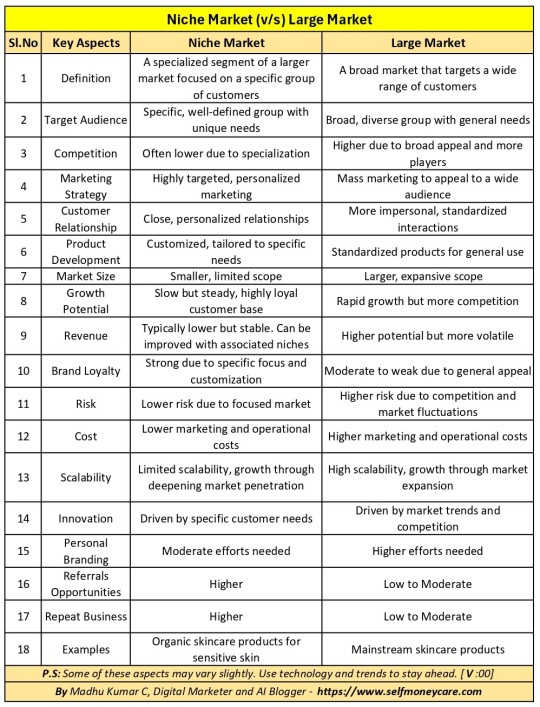
Niche Market vs Large Market:
Here's related information that you may also find helpful – How To Find Micro-Niche Ideas? [involving tools and platforms].
#niche market#niche marketing#digital marketing#broad market#market segmentation#personalization#micro niche
1 note
·
View note
Text
Micro Data Center Market: Forthcoming Trends and Share Analysis by 2030
Micro Data Center Market Size Was Valued at USD 5.7 Billion in 2023, and is Projected to Reach USD 55.3 Billion by 2032, Growing at a CAGR of 28.8% From 2024-2032.
A mini data center is a secure, self-contained device that has all the electricity, ventilation, rack space, and uninterruptible power supply needed to house all of the essential IT components plus management and monitoring software. Micro data centers allow companies to reduce their energy, footprint, and capital costs while also speeding up deployment. Organizations are motivated to implement micro data solutions at peripheral locations by the many advantages offered by micro facilities, including mobility, cost-effectiveness, enhanced networking and connectivity, and power economy. Moreover, the capacity to quickly deploy these tiny data centers or containerized (modular) buildings allows businesses to increase their operational activity in reaction to surges in computing demand.
While the construction of micro data center facilities at the necessary sites takes about one week, the deployment of conventional IT facilities at network locations usually takes more than a month. These factors encourage the market for mini data centers to grow.
Get Full PDF Sample Copy of Report: (Including Full TOC, List of Tables & Figures, Chart) @
https://introspectivemarketresearch.com/request/4919
Updated Version 2024 is available our Sample Report May Includes the:
Scope For 2024
Brief Introduction to the research report.
Table of Contents (Scope covered as a part of the study)
Top players in the market
Research framework (structure of the report)
Research methodology adopted by Worldwide Market Reports
Leading players involved in the Micro Data Center Market include:
Vertiv Co, Schneider Electric SE, IBM Corporation, Dell Inc, Huawei Technologies Co. Ltd, Hewlett Packard Enterprise Company, Eaton Corporation,and Other Key Players
Moreover, the report includes significant chapters such as Patent Analysis, Regulatory Framework, Technology Roadmap, BCG Matrix, Heat Map Analysis, Price Trend Analysis, and Investment Analysis which help to understand the market direction and movement in the current and upcoming years.
If You Have Any Query Micro Data Center Market Report, Visit:
https://introspectivemarketresearch.com/inquiry/4919
Segmentation of Micro Data Center Market:
By Component
Solutions
Service
By Application
BFSI
Energy
Government
Healthcare
Industrial
IT & Telecom
Others
Market Segment by Regions: -
North America (US, Canada, Mexico)
Eastern Europe (Bulgaria, The Czech Republic, Hungary, Poland, Romania, Rest of Eastern Europe)
Western Europe (Germany, UK, France, Netherlands, Italy, Russia, Spain, Rest of Western Europe)
Asia Pacific (China, India, Japan, South Korea, Malaysia, Thailand, Vietnam, The Philippines, Australia, New Zealand, Rest of APAC)
Middle East & Africa (Turkey, Bahrain, Kuwait, Saudi Arabia, Qatar, UAE, Israel, South Africa)
South America (Brazil, Argentina, Rest of SA)
Key Benefits of Micro Data Center Market Research:
Research Report covers the Industry drivers, restraints, opportunities and challenges
Competitive landscape & strategies of leading key players
Potential & niche segments and regional analysis exhibiting promising growth covered in the study
Recent industry trends and market developments
Research provides historical, current, and projected market size & share, in terms of value
Market intelligence to enable effective decision making
Growth opportunities and trend analysis
Covid-19 Impact analysis and analysis to Micro Data Center market
If you require any specific information that is not covered currently within the scope of the report, we will provide the same as a part of the customization.
Acquire This Reports: -
https://introspectivemarketresearch.com/checkout/?user=1&_sid=4919
About us:
Introspective Market Research (introspectivemarketresearch.com) is a visionary research consulting firm dedicated to assist our clients grow and have a successful impact on the market. Our team at IMR is ready to assist our clients flourish their business by offering strategies to gain success and monopoly in their respective fields. We are a global market research company, specialized in using big data and advanced analytics to show the bigger picture of the market trends. We help our clients to think differently and build better tomorrow for all of us. We are a technology-driven research company, we analyze extremely large sets of data to discover deeper insights and provide conclusive consulting. We not only provide intelligence solutions, but we help our clients in how they can achieve their goals.
Contact us:
Introspective Market Research
3001 S King Drive,
Chicago, Illinois
60616 USA
Ph no: +1 773 382 1049
Email: [email protected]
#Micro Data Center#Micro Data Center Market#Micro Data Center Market Size#Micro Data Center Market Share#Micro Data Center Market Growth#Micro Data Center Market Trend#Micro Data Center Market segment#Micro Data Center Market Opportunity#Micro Data Center Market Analysis 2024
0 notes
Text

Micro-Moments Unfolded: How Brands Ride the Spontaneity Wave - Coho AI
Micro-moments emerge when consumers reflexively turn to a device, predominantly a smartphone, as a response to an instantaneous need or curiosity. They aren’t just confined to purchasing decisions. They encapsulate a spectrum of actions: “I want to know,” where a user might be looking up a fact or information; “I want to buy,” which can lead them down a purchasing rabbit hole; “I want to go,” guiding them to seek out locations or experiences; or even “I want to do,” pushing them to explore a new activity or hobby. These moments are fleeting but potent, representing pivotal junctures in the decision-making process. https://www.coho.ai/blog/micro-moments/
#conversion rate optimisation strategy#behavioral targeting technology#best b2c crm solution#micro segmentation marketing#segmentation tool#customer retention management software
0 notes
Text
hi yes is it just my eyes glazing over as i "read" through this? no? just me? okay.


.... /nods
lmao don't smile at us like that
edit THANK YOU CID


lmfaoooo this poor girl


nope.
tldr:

#arcanist flashbacks .-.#zwei writes#does this mean that the proto-fluctuations in the anti-aether indicate that a micro-millenium's worth of ARV segments exist too?#see. i can ALSO use the BIG WORDS#ffxiv
1 note
·
View note
Link
Class C IP Checker - Analyze Your IP Network Segmentation
#Class C IP Checker#Free Micro Tools#IP analysis#network segmentation#IP management#SEO tools#IP class distribution#network management
0 notes
Text
The Business Research Company offers automotive micro motor market research report 2023 with industry size, share, segments and market growth
#automotive micro motor market#automotive micro motor market segments#automotive micro motor industry#automotive micro motor market growth#automotive micro motor market size#automotive micro motor market share#automotive micro motor market report#automotive micro motor market forecast#automotive micro motor market analysis#automotive micro motor market overview#automotive micro motor market outlook#automotive micro motor market research
0 notes
Text
David Gaider: "It occurs to me, after reading posts getting it spectacularly wrong, that there are a lot of misconceptions over how game studios organize and, in particular, who makes the actual decisions about what ends up in your game. Much of it is by folks who don't *try* to get it... but not all, surely. I'll explain it a bit, but a big caveat: I'm going to talk in generalities and roles. Actual titles vary (a lot) from studio and studio, and the bigger a studio is the more segmented their departments (and thus management) is going to be. Even so, most studios, big and small, kind of work the same. To start, you're going to break your devs up into at least three groups: design (what is the game? how does it work?), art (what will it look like?), and engineering (making it go). There can be a lot of cross-over and some departments that don't fit into a project structure (QA, Marketing, etc.)"

Rest of post under cut due to length.
"There's going to be someone in charge of these groups - these are usually called "leads" or "senior leads". The actual title varies. The Design Lead could be a Lead Designer, for instance, or it could be a Creative Director and a Lead Designer is what they call someone further down the chain."
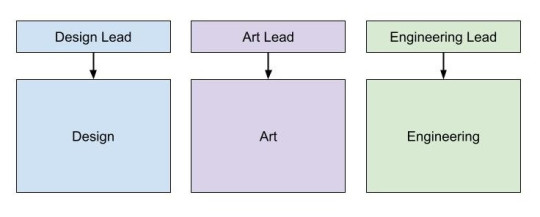
"These leads all report to a Project Director, someone who's job it is to manage the project as a whole. Now, this part gets a little dicey. Depending on the studio, this role can be anything from more production-oriented (they control the schedule) to an outright auteur who micro-manages everything."

"More importantly, it's the PD who hands down the project goals to the Leads: the strategic goals, the needed features, the shape of it all, etc. The Leads then figure out how their department is going to tackle those, and work with each other. If the Leads conflict, it's the PD's role to solve it. How much autonomy or ownership those Leads have is, like I said, really up to the individual PD and that studio's culture. Even in the case of a PD who has a lot of authority over the project, however, they still report to the studio leadership (unless it's the same person, like in a small studio)."
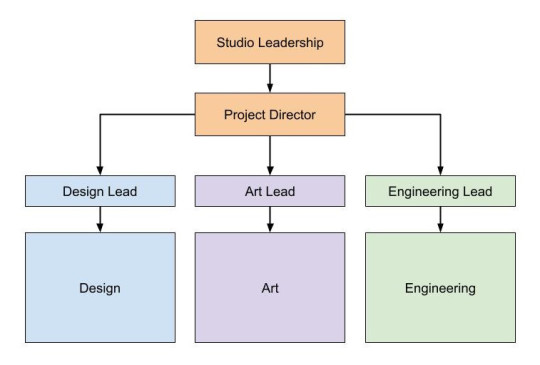
"The studio leadership is going to be giving the PD their marching orders, often in the form of those strategic goals. If there's a publisher involved, that's where the studio leadership is likely getting those goals. The PD, then, ends up being the person who has to negotiate with everyone above."

"What does this mean? If the studio or publisher has concerns about the project, they're calling in the PD to explain. If the project needs more time or resources, it's on the PD to explain to them why and how and when. If there are a lot of layers above the PD... yes, it's a looot of meetings. So while the PD is managing up, the Leads are managing down. With big projects, that means managing the "sub-leads"... those in charge of the individual sections of their department. It'd be unmanageable otherwise, and the bigger the project the more of these there are going to be."

"What does this mean? Well, let's look at the way BioWare broke up Design (as of 8 years ago, anyhow). Design consisted of Narrative Design, Level Design, Systems Design, Gameplay Design, and Cinematic Design (who worked in tandem with Cinematic Animation, which actually fell under the Art Lead)."

"The sub-leads are handed their goals by the lead, and work out how they're going to produce their particular corner of the game and also, more importantly, how they're going to work with each other. Conflicts between sub-leads are handled by the lead, as are ANY conflicts with other departments. What conflicts could there be, you ask? Dependencies, for one. "I can't do X until Y is done, but Y is someone else's job". Or scope. "We need 20 doodads but the sub-lead said they only have time to make 10, what now?". Even outright differences in vision. Big projects means room for a LOT of egos. If you think this is easier with a smaller (or indie) project, the answer is "yes, but not really". The roles are still necessary but often get combined into one person. Or outsourced, and someone still needs to manage the outsourcing. Things fall off over-full plates. It's a different kind of hard. Anyhow, the point of all this is: the further you go down the chain, the smaller the box you can play in is. The less you have actual say over, and even then that say is subject to being overridden by ANYONE above... and must still play nicely with the needs and goals of the other departments. You also need to keep in mind that projects are constantly in flux. Problems that were thought solved need re-solving. The team falls behind schedule and scope needs to change. You are constantly in a dance, within your tiny box, trying to figure out sub-optimal solutions that cause the least pain. And there will be pain. Shit rolls downhill, as they say, and when the project encounters big issues that means those high up have the sad job of figuring out how to spread it out and who can afford to take the hardest hit. If you're that one, you take it on the chin and you deal. This is the job. Lastly, I'll re-iterate: not every studio works this way, exactly. The roles exist, sure, but are not divided up so neatly or as easily identifiable. Even so, this should give you an idea what "lead" and "sub-lead" mean... and perhaps help you imagine what it's like existing further down the chain."
[source thread]
374 notes
·
View notes
Text
How the world works
The world is broken up into several distinct classes of people, centered around gender and function! A lot of people seem confused about what this model looks like, so I'll explain it for you!
At the top
In no particular order, this upper segment of society is elegratarian among it's ranks when society is functioning properly, though some cultures will assign micro-ranking among these tiers.
Trans Women- (Also known as True Women) Divine and respected, a Trans Woman has undergone the holy act of being chosen, by fate or Herself, to become a Woman. While oftentimes this comes with self-modification and self-creation from a medical standpoint, just knowing and announcing oneself as a Trans Woman is enough to be recognized as one of this gender class.
Trans Men- (Also known as True Men) Much like Trans Women, Trans Man has undergone the holy act of being chosen, by fate or Himself, to become a Man. Just as in the case of Trans Women, medical self-creation is common and holy, but not required for the Trans Man to be recognized as who He is.
Non-Binary Persons- (Also known as True (how the individual sees Themself)) As equal to their binary counterparts, Non-Binary (or Nonbinary, both writings are correct) Persons have undergone the holy act of casting-off confinement to one gender box. While some may align to one "common" gender or another, others forego gender altogether or craft their own like a god creating a personal universe. Much like with Trans Women and Trans Men, medical self-creation is common, but not required- self-understanding is all that is necessary to assert this gender class.
Midway Point
These less enlightened gender classes often bicker amongst themselves to assert dominance among each other. Whoever comes out on top is irrelevant, as long as they respect their place in the hierarchy below. There are occasions when someone in this tier attempts to assert dominance over someone in the above tier, which should be met immediately with violence.
Ciswomen- Often written as "women" to try to imitate Trans Women, ciswomen are afforded this state by fate. They are not strong enough or are not beloved enough by fate to be able to choose anything different, but are afforded status by being the favored plaything of the True Genders more often than lower classes. They have agency and personhood, enough to decide if they want to be part of the breeder population or not, as long as they aren't owned by a True Gender that says otherwise.
Cismen- often written as "men" in an attempt to gain status from their proximity to Trans Men, cismen are fated to share this middle spot in the gender heirarchy with ciswomen. Despite having agency and personhood, they're bound by fate or weakness of will to this lower tier under the True Genders.
Low Teirs
These gender segments are far more regimented among their lower ranks- the lower they are listed, the higher their status.
Bimbo- While a lower tier, a bimbo has a higher state of existence compared to other lower tier genders due to their high sexual utility and general positive impact on society. While a bimbo can come from any higher class (including True Genders), the bimbo debases itself for the benefit of others. Generally thoughtless, peppy and sexy, this affords even the lowest ranking bimbo a place that is respected in society- not as an equal, but as a utility. They're often not breeders, but pregnant bimbos have been seen more often in places with a lower population of wombs and fakeboys. Due to their higher status and almost spiritual state, bimbos are afforded some level of agency and personhood, if in a limited capacity.
(X)-bait- Bait type genders often are either former cisgenders, or elevated fakegenders. The X can be any number of things, from rape to abuse to snuff, but their elevation comes from the entertainment and enjoyment of doing the baited action against the will of the individual. They lack agency, but hold onto a shred of personhood.
Pet- A pet can be any number of creatures, commonly puppygirls or catboys for example, whose existence is focused around serving or entertaining an owner. They have no semblance of agency and are considered only a step above animals due to their capacity to consent, but consent is not required to fuck a pet. Most are pampered and loved, and being a well loved pet can be a goal for an otherwise lost and ungendered person- some True Genders are also pets, but unlike the bimbo this does not lower their status except among their True Gender peers.
Fakegirl- Fakegirls, or boys, are a class of person attempting falsely to claim to be a Trans Woman. They are distinct from the Trans Woman due to the fact that they get aroused by reminding them of the body they were afforded at birth, and reminded that they will never be a True Woman. Fakegirls upset the natural order and are an affront to True Genders, and are often punished by further masculinization and use as breeding studs. Medically altered fakegirls are often used as sex objects, due to the lessened or lack of breeding ability.
Fakeboy- Fakeboys, or girls, are those who falsely claimed to be True Men at some point in their lives and need both punishment and correction. Bound by the will of their cunts, the primary role of the fakeboy is to be a breeder for genders that know better. With any luck, a corrected fakeboy can return to its cis gender class, or become a pet or bimbo if they aren't too far gone to delusion. Medically altered fakeboys are often seen as fetish objects, especially those who have a lessened or no capacity for breeding.
Subhumans
Barely able to be called living things, these genders have no ranking among themselves because they lack the capacity for higher thought.
Wombs- Wombs are things that exist purely for breeding purposes. They are sex objects that can get pregnant, tits that produce milk for the offspring incubating inside, and are thought to have no higher thought or reasoning. They make a very good imitation of humanity, some even claiming to be other genders, but the dead-eyed look gives away a lack of internal self, despite the screaming.
Cocks- Counterpart to the womb, cocks are effectively autonomous seeders. They play a convincing human, but are not a real person. They can be used to seed higher genders for breeding purposes, or to inseminate wombs.
Toys- A toy is something that another gender can choose to be, or is something someone is born as. Regardless of how a toy comes to be, toys exist to give sexual pleasure to it's owner and nothing else. There is no attempt to imitate humanity from a toy, of which there are several sub-classes, the toy knows what it is. It has a higher level of awareness than a womb or a cock, but uses that awareness to be utilized or seek out someone to use it.
Conclusion
There are many different types of genders out there! It's important to know who and what you're talking to online, to maintain the order of things! I hope my explanation helped, and I'm very open to feedback! :3
#long post#trans supremacy#trans superiority#fakeboy#fakegirl#bimboification#bioessentialism kink#gender play#cvntboy#ftm breeding#cvmdump#forced impreg#impregnate her#trans breeding#toyification#petpl@y
85 notes
·
View notes
Text
A Tiny Table System?! It's more likely than you think....

We at Tiny Table teach, play and review trpgs, but did you know that Julian is writing one too? Our benevolent Game Mistress wants to free us from the shackles of DND 5e (a jape for all the 5e warriors with pitchforks and torches rapidly approaching our location) and is walking us through the process. Introducing Julian Jame Design, the hottest recurring Side Table segment, where each of us take turns interviewing Julian on her game system as she guides us through the development phase. From creating social encounters to using fighting game mechanics in combat, listen as Julian gives us a peek into that beautiful brain of hers. Julian Jame Design is exclusively on our Micro Tier level on Patreon, but you can also buy the individual episodes for $8 each if you aren't looking to add a recurring subscription to your budget. Julian is always looking for feedback and we'd love to hear what you have to think about the system so far! We have three episodes out now and we think it's already something pretty special!
Episode 1
Episode 2
Episode 3
#ttrpg#indie ttrpg#not dnd#indie ttrpgs#ttrpg design#ttrpg stuff#ttrpg community#ttrpg podcast#actual play podcast#tabletop rpg#tiny table
79 notes
·
View notes
Text
Taxonomy Tournament: Invertibrates
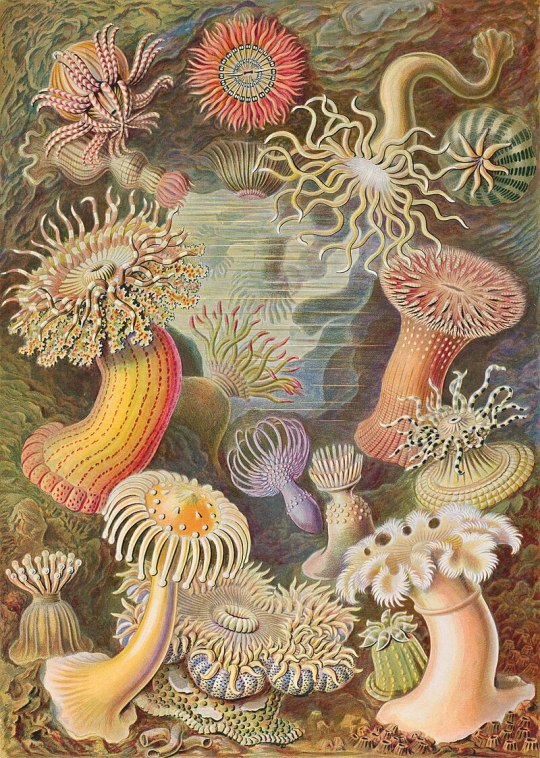

Hexacorallia. This class is made up of aquatic animals with 6-fold symmetry. It includes stony corals and sea anemones
Tardigrada. This phylum is made up of tardigrades, also known as water bears, eight-legged segmented micro-animals. They're among the most resilient animals, able to survive high and low extremes in temperature and pressure.
#animals#biology#polls#poll tournament#zoology#Animal Tournament Round 4#coral#sea anemones#cnidarians#tardigrades#water bears#ecdytes#Hexacorallia#Tardigrada#0x16v0x17
139 notes
·
View notes
Text
Wet Beast Wednesday: tardigrades
Last week on Wet Beast Wednesday I covered the largest animals to ever exist on our planet. This week I'm going to pull a full 180 and cover the smallest animals yet on this series. Meet the tardigrade, the internet's favorite micro-animal the is said to be basically immortal. How true is that? Let's see.
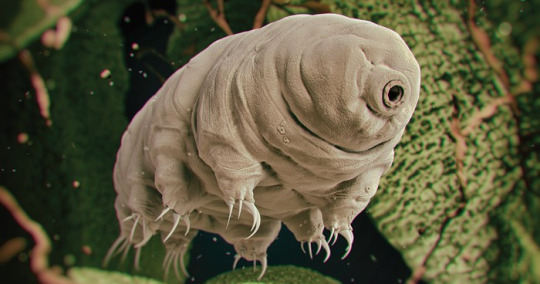
(Image: an electron microscope image of a tardigrade. It looks a lot like a potato with eight stubby legs tipped with long claws. At the front is a small, circular mouth. It has no other discernable features. In the background are bits of plant matter that look like seaweed at this scale. End ID)
The tardigrades are 1,300 known species (and probably a lot of unknown ones too) in the phylum Tardigrada. They are also part of the superphylum Ecdysozoa, which are animals that grow by molting their outer cuticles or exoskeletons. In particular, the tardigrades are believed to be a sister group of the arthropods, the group that contains crustaceans, insects, isopods, and a lot of other things. Tardigrades are truly tiny, the largest species reaching a whopping 1.5 millimeters in length, though most species reach no more than 0.5 mm. They have round, segmented bodies with four pairs of legs that end in either claws or suction discs. The body segments consist of a head, three body segments with a pair of legs each, and a caudal segment with the final pair of legs. The first three legs are used for movement while the final pair points backwards and is used for grabbing onto substrate. All of the body segments except for the final one correspond to segments found in the head section of insects. Tardigrades are missing many hox genes, genes that direct the body plan during development. Their ancestors may have had a body plan more similar to insects, but the loss of the hox genes has compressed them into walking heads with a bit of butt. The mouth is tubular and sucks in food. In the mouth are stylets, needle-like structures used to pierce food objects. Once food is drawn into the mouth, a structure called the buccopharyngeal apparatus activates. This is a combination of spines and muscle that acts like an inner jaw that pulls food into the digestive tract. The buccopharyngeal apparatus is distinct enough to be used as a major identifying feature between species. Tardigrades are translucent and many images you've seen of them have false color to show the details or are 3D models based on scanning electron microscope imagery of them. Tardigrades molt their exoskeletons multiple times (up to 12) during their lifecycle. Some species are unable to poop normally and instead all their waste is discarded during the molt. It was formerly believed that tardigrades could exchange genes with each other without mating, a process called horizontal gene transfer that is seen in bacteria, archaea, and other micro-organisms. It has since been discovered that while still capable of horizontal gene transfer, it is quite a bit rarer in tardigrades than we thought.
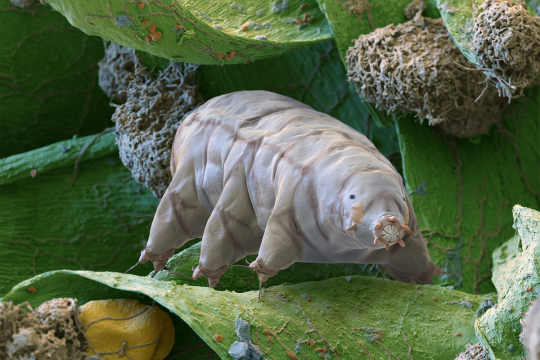
(Image: an electron microscope image of a tardigrade standing on a bit of plant matter. This one has a closed mouth with a ring of triangular tooth-like structures. It also has two simple eyes that look like black dots. End ID)
The name "tardigrade" means "slow walker", which is fitting as, despite their eight legs, tardigrades have a slow and awkward gait. This is the result of their legs being unjointed, only able to pivot at their connection to the body. Their gait has been compared to that of bears, hence why they are often called water bears and their discoverer, Johann August Ephraim Goeze, called them "kleiner wasserbär", meaning "little water bear". Tardigrades are found worldwide and have inhabited virtually every habitat, from the tops of mountains to the deep sea, from hot springs to the antarctic, from freshwater to saltwater. The one thing they have in common is a need to stay wet. Tardigrades can survive out of water as long as they can stay moist and are often found in mosses, hence another common name: moss piglets. The majority either eat plants or bacteria, but some will feed on smaller tardigrades or other micro-animals. Their famous survivability makes it easy for tardigrades or their eggs to be carried to new habitats by larger animals or other phenomena. Tardigrades are one of the first micro-animals to colonize a new habitat and they are a pioneer species, the first species to colonize a new environment and whose presence makes that environment fore suitable for other species to follow. Tardigrades are a major food source to other micro-animals and larger organisms. Most species have distinct males and females, though a few reproduce through parthenogenesis. In most cases, molting female will lay her eggs in her shed cuticle and males will them fertilize them. Other species have a form of internal reproduction. Males and females will court each other before mating and females will usually allow multiple males to fertilize her eggs. Female tardigrades are typically larger and more abundant than males. Eggs can take up to 14 days (species dependent) before hatching. All tardigrades of the same species have the exact same number of cells as each other. They are also born with the same number of cells they will have as an adult. Their growth is driven by enlargement of the existing cells rather than cellular reproduction making new cells. The lifespan ranges between a few months to a few years, depending on species.
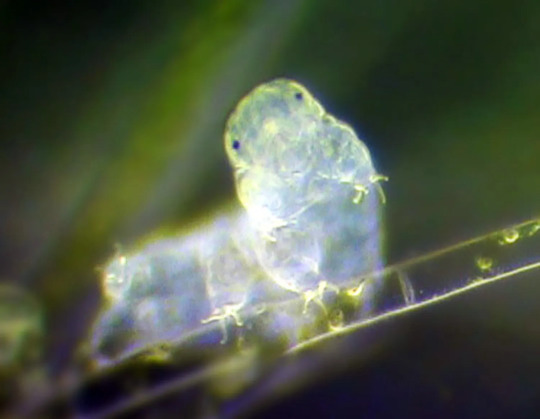
(Image: a color photo of a tardigrade. It is a pale, translucent white, making it hard to make out details. Its body is curved, with the front end pointing at the camera. It has two simple eyes. End ID)
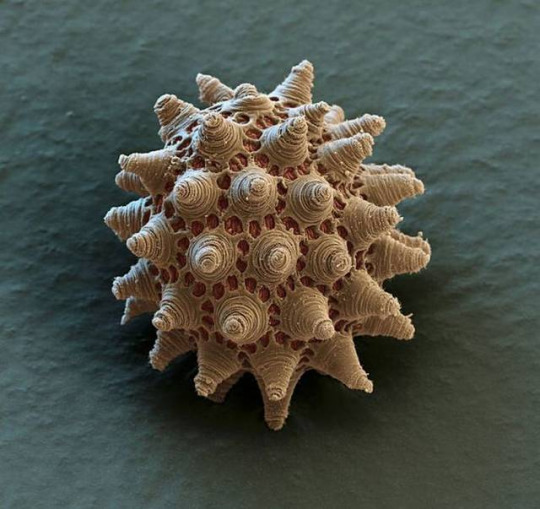
(Image: an electron microscope image of a tardigrade egg. It is round but covered in small pores and conical structures. End ID)
The most famous feature of tardigrades is their legendary durability. It is commonly said that tardigrades can survive just about anything (except for the things that are actually trying to kill them. They are prey to a lot of species after all). Among the things they can survive is extreme heat, extreme cold, dehydration, extremely high and low pressure, exposure to ionizing radiation (that's the scary kind), low oxygen environments, environmental toxins, heavy impacts, and the vacuum of fucking space. While the can survive in extreme conditions, tardigrades are not considered extremophiles. True extremophiles thrive in extreme environments and are negatively impacted by leaving them. Tardigrades can survive in extreme environments, but are negatively impacted and can't survive as well there as they can in less extreme places. The main trait that has allowed tardigrades to survive all five mass extinctions in history is cryptobiosis. Cryptobiosis is the rare ability for an animal to enter a state of dormancy where their metabolic processes come to an almost complete stop. While in cryptobiosis, metabolic activity drops to 0.01% normal and water content drops to 1% normal. In this state, the tardigrade is called a tun. Tardigrades usually enter cryptobiosis in response to arid conditions. One experiment showed that a species of tardigrade could last for at least 30 years in this state and return to normal lifestyle functions when exposed to water. Tardigrades will also enter cryptobiosis in response to low oxygen, toxic chemical exposure, increased or decreased temperature, and excessive salt content in the water. Tardigrades also show extreme resistance to both high and low pressure. They can live in 0 atmospheres of pressure and some species can survive up to 6,000 atmospheres, more than double the pressure at the bottom of the Marianas trench. More interesting is their ability to survive dangerous radiation. They can survive 1,000 times the dose of gamma radiation that humans can. Early tests focused on tardigrades in cryptobiosis and concluded that the extremely low water content of a cryptobiotic tardigrade doesn't leave much opportunity for the radiation to react with the animal. However it was later found that active and fully hydrated tardigrades are still considerably resistant to radiation. Studies into this resistance indicate that tardigrades can very efficiently repair damaged DNA and have unique proteins called Dsup that provides additional protection. Dsup introduced to human cells has provided additional protection against x-rays.
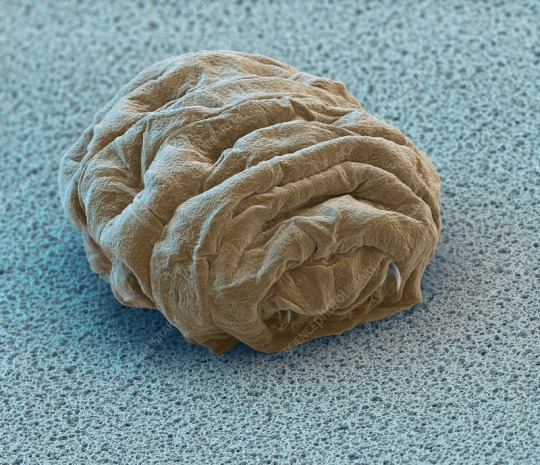
(Image: an electron microscope image of a tun - a tardigrade in cryptobiosis. It is smaller and very wrinkly, with the legs and mouth retracted into the body. End ID)
Tardigrades were the first animals to be exposed to the vacuum of space. They were exposed for 10 days, some in a state of cryptobiosis at the time of exposure and some still active. It was found that they were able to survive the vacuum when shielded from the sun's ultraviolet radiation, with those already in cryptobiosis doing better. Upon being rehydrated, many were able to resume normal life functions and successfully reproduce, though others died after being rehydrated. Those that were exposed to UV radiation fared much worse, with only a few hydrated individuals surviving. The individuals in cryptobiosis had a lower survival rate when exposed to UV than those not exposed to UV and were less successful at reproducing afterwards. Studies of tardigrade's space survival abilities and resistance to radiation could go a long way in helping human space travel. One of the largest dangers of space travel is that space is full of nasty radiation from the sun that Earth's magnetic field protects us from. Some scientists speculate about the possibility of accidentally seeding other planets or moons with tardigrades or other space-resistant organisms. This is a problem because introducing Earth life to other world has the potential to damage any native ecosystems and if we find life in space in the future we don't want to have to figure out if it's something we accidentally put there. While tardigrades could likely survive on other planets, they would eventually die without a food source. Some sources reported that tardigrades may have colonized the moon after an experiment with them crashed. Unfortunately, the moon is not crawling with tardigrades now. It's way too dry for them to exit cryptobiosis even if they survived the crash, which they probably didn't.
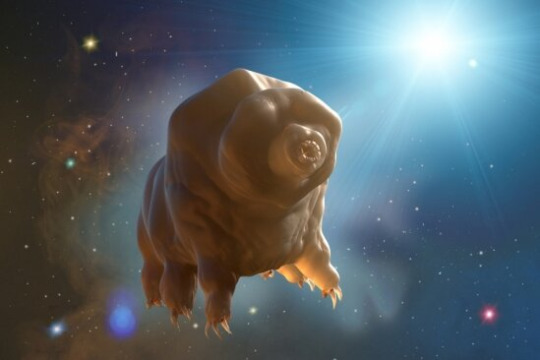
(Image: art of a tardigrade floating in the vacuum of space. End ID. Source: University of California - Santa Barbara)
#wet beast wednesday#tardigrade#water bear#moss piglet#micro animal#microbiology#marine biology#biology#zoology#ecology#animal facts#informative#science#space#astrobiology#radiation#cryptobiosis#tun#image described
199 notes
·
View notes
Text



Quester (1981) by David Buckley, London, UK. Quester was originally designed as a micromouse maze solver, taking part in the Wembley heats of the July 1981 Amazing Micromouse Contest, and in the September 1981 EUROMICRO competition in Paris. It was later converted into a general purpose robot with the addition of a gripper. It uses vision to detect the walls of the maze, and segmented bump sensors in case it doesn't, and uses a layered behaviour control program running on a 6502 based Acorn System 1. Quester was also a finalist in the Robotics Age "Home Robot Photo Contest" (1982), and ultimately won the Thezeus Award 1996 created and presented by Alan Dibley.
"The chassis consists of two main drive wheels with fore and aft casters. The drive wheels are hardboard disks with vacuum-cleaner belts for tires, each powered by a 6V DC motor. Via homemade shaft encoders the motors also drive two 8-bit up/down counters so that a preprogrammed path may be followed. Wire loops connected to micro-switches can be seen around the base - these provide reflexes through hardware timers on the interface board. Power comes from a 6V lead-acid battery in the central column which allows about three hours of service between charges. Twelve photo-transistors arranged as three pairs per side provide obstacle detection. One of each pair senses ambient light while the other is only sensitive to light from a particular direction. … At the front of the chassis are a pair of ultrasonic transducers for range-finding." – Quester, by David L. Buckley, Robotics Age, Jan/Feb 1982.
35 notes
·
View notes
Text

Apportez du peps en fin de repas avec notre recette de clafoutis à l'orange et au pralin ! Idéal pour un repas d'hiver, ce flan aux agrumes régalera tous vos convives avec sa recette toute simple et rapide à réaliser : suivez le guide...
Nombre de personnes6
Temps de préparation10 minutes
Temps de cuisson35 minutes
Degré de difficultéTrès facile
CoûtBon marché
4 œufs
150 g de sucre en poudre
1 pincée de sel
1 sachet de sucre vanillé
25 cl de lait
20 cl de crème liquide
100 g de farine + pour le moule
4 oranges bio : 2 pour le zeste et le jus + 2 pour les quartiers
100 g de pralin en poudre
30 g de beurre + pour le moule
Sucre glace pour la décoration
Préchauffez le four à 180°C (th. 6). Beurrez et farinez légèrement un moule à tarte ou un moule à gratin.
Dans un saladier, battez les œufs avec le sucre, le sucre vanillé et une pincée de sel jusqu'à ce que le mélange devienne léger et mousseux.
Ajoutez le lait, la crème liquide, le zeste et le jus de 2 oranges, puis mélangez bien pour obtenir une pâte homogène.
Incorporez la farine en plusieurs fois, puis continuez de battre jusqu'à ce que la pâte soit lisse et sans grumeaux.
Faites fondre le beurre dans une petite casserole ou au micro-ondes, puis incorporez-le à la pâte. Mélangez bien.
Épluchez les 2 oranges restantes et découpez-les en quartiers. Si vous préférez une présentation plus fine, vous pouvez également retirer les membranes pour ne garder que les segments d'orange.
Versez la préparation dans le moule. Ajoutez les quartiers d'orange dans la pâte en les disposant en rosace par exemple, en les enfonçant légèrement sans les immerger complètement.
Parsemez le pralin en poudre sur le dessus.
Enfournez pour environ 35 à 40 minutes. Le clafoutis doit être légèrement doré sur le dessus et encore un peu tremblotant au centre. Si le dessus dore trop vite, vous pouvez couvrir avec du papier aluminium pour la fin de la cuisson.
Saupoudrez de sucre glace avant de servir, pour apporter un peu de douceur et de brillance.
Vous pouvez servir ce clafoutis aux agrumes tiède ou froid, accompagné, si vous le souhaitez, d'une boule de glace à la vanille ou d'une cuillerée de crème fouettée.
21 notes
·
View notes
Text
CATS or What Is This RPG or Setting The Table
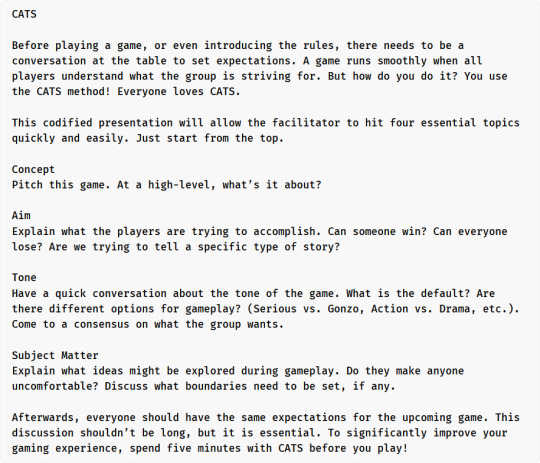
So I just heard about CATS courtesy of the good folks in the PlusOneExp discord server. CATS was written by Patrick O'Leary for the 2016 200 Word RPG Challenge.
It's nice and short (200 words even) and it's a compelling formula for the classic What Is This TTRPG segment that warrants a page at the front of every good RPG book.
I find it particularly interesting that this is imagined as a micro-RPG in its own right, a table activity for the start of game night that sets out to address what I have always found to be the most painful aspect of playing any TTRPG (besides tedious and arcane character creation rituals – I'm looking at you 5e PHB 👀): the friction that arises from players having discordant, conflicting, contradictory or incompatible expectations during play.
We can formulate the basic strucure of CATS in a variety of ways: Concept/Aim/Tone/Subject Matter, What/Where/When/Who/Why/How, Premise/Overview/Goals/What You Need, etc. all of which can be applied in two immediate directions:
In a What Is This RPG section, these are just codified methods for teaching the player/reader (more of my thoughts on the player/reader here) how to read and communicate everything that comes next in a way that's both more focused than a blurb (which might basically constitute the Concept/Premise/Hook) and more comprehensive than an elevator pitch.
As a launchpad for table play, these structures guide the conversation to establish the pillars of the shared fiction, and I especially appreciate CATS for the fact that it ends on Subject Matter. It could be the consequence of a tortured acronym, but having set the stage in every other way it seems appropriate to hop into safety tools as the final as the final negotiation before play, once all context is provided but nothing is yet set in stone.
That's all he wrote on CATS.
In THE PERILOUS PEAR & PLUM PIES OF PUDWICK I wrote a conversation guide to the meat of the adventure on pg. 11, following an introductory segment of the game that functions as a session 1 prologue of sorts before delving into the hexflower "dungeon" microsetting, inciting incident et al. It's interesting for me to look back at the way I structured this from the perspective of CATS.
If you're curious about TPPAPPOP and want a sneak peak of what you can expect, here's that segment from pg. 11, Inside The Tree:
Resources: the insects of the tree live in darkness and have varying weird diets – you might decide that tracking resources like light and food is important, or maybe at this scale adventurers can survive on the honeydew, leaves and strange meats that the insects eat. Sights and Sounds: footsteps might sound like earthquakes, voices like distant thunder. What are the twitches and mannerisms of the chittering language of insects? How does artificial light disturb the denizens of the tree? Setting and Tone: to adjust the game to your group's preference, you might lean into the existential conflict of intruding on and potentially dooming these fledgling societies, or downplay the crawling horror of an insect world to allow its cuter side to shine through.
#TPPAPPOP#TTRPG#indie TTRPG#indie tabletop#tabletop#ttrpg design#bugs bugs bugs#d&d#CATS#5e#tabletop design#indie dev#TTRPG dev
246 notes
·
View notes